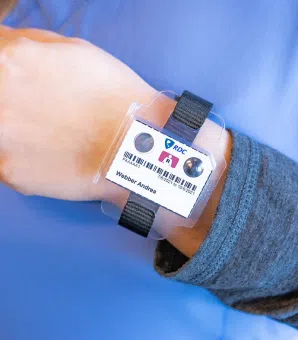
Dosimeter badge services for medical, dental, and veterinary businesses
Learn how Radiation Detection Company’s easy-to-use dosimetry solutions can boost the efficiency of your practice.
There are many different types of radiation dosimeters available for use today, and they all play a critical role in an organization's adherence to comprehensive radiation safety protocols. These dosimeters assist in the collection of exposure data in the workplace, aid in assessing potential health risks, and allow organizations to maintain regulatory compliance.
In this article, we'll dive deeper into the differences in dosimeters currently available for use in the workplace.
We hope you find this article informative, and as always, we look forward to hearing your feedback!
It is normal for those that come in contact with radioactive materials and X-ray generating devices during the regular course of their employment (or those who have the potential to be exposed to radiation), to carry personal radiation dosimeters.
Personal dose equivalent is an operational quantity for individual monitoring of radiation exposure.
The personal dose equivalent (sometimes referred occupational dose or dose) is defined as the dose in tissue at an appropriate depth in human body.
Personal dose equivalent, Hp(0.07) also known as shallow dose equivalent is the quantity that is used for the assessment of the dose to the skin and to the hands below elbow and feet below the knee.
Personal dose equivalent, Hp(10) also known as deep dose equivalent is the quantity that is used for the assessment of the dose to the whole-body including areas above the elbow, knees and including the head.
Personal radiation dosimeters are specifically designed to record and indicate dose equivalent to ensure the dose is within the allowable limits and regulatory compliance is achieved.
There are many different types of dosimeters on the market these days that typically fall into one of the following categories: active, passive and digital. Below we'll explore the different dosimeter offerings currently available.
For more information on personal radiation monitoring in a multitude of workplace settings (including medical, veterinary, dental, and more), please refer to our recent article, "Radiation Badges to Use Based on Your Specific Work Needs."

Active and electronic personal dosimeters measure instantaneous doses, which can provide a visual and audible alert to possible exposure, the dose and dose rate, and follow the variations of radiation exposure over time. Personal radiation detectors – like electronic personal dosimeters (EPD), personal emergency radiation detectors, and a quartz fiber dosimeter – play a major role in active dosimetry. Active dosimeters generally require an external source of energy, like a battery to operate.
These dosimeters have continuous monitoring can allow for audible alarm warnings at preset levels of exposure, as well as a perpetual live readout of the radiation dose accumulated. This dosimeter is to supplement passive and semi-passive dosimetry in the case of high radiation levels and/or dose optimization purposes but typically isn't accredited for reporting purposes.
Passive dosimeters (TLD and OSL) do not need an external source of energy to operate as the signal is stored in the device. They are also known as integrating dosimeters, which means they only give an estimate of the cumulative dose. Passive dosimeters record how much radiation an individual is exposed to over a specific period of time (i.e. a week, month, quarter, or year). They do not provide direct readout of dose and analysis is completed in a lab.
A digital dosimeter is a modern dosimeter used for measuring the dose a person receives. This dosimeter can provide real-time information about the measured dose for the individual wearing the device. As a semi-passive badge, it has a battery that can read dose levels at any time and is stored within the device.
Digital dosimeters are usually worn on the outside of clothing (the same as passive dosimeters)- generally on the chest or torso - to represent the radiation dose to the whole body. By wearing a digital dosimeter in that spot, it's able to monitor exposure of most of the vital organs, while also representing the bulk of a body's mass.
The NetDose dosimeter (Type 600295-A) utilizes silicon photomultiplier (SiPM) technology for real-time dose determination with a minimal reportable dose of 1 mrem (0.01 mSv).
The NetDose dosimeter is used to monitor occupational exposure to an individual working with radioactive materials emitting gamma rays and/or X-rays and X-ray generating devices.
This dosimeter ensures the dose received remains within the allowable dose limits and provides organizations with real-time insights and peace of mind in confirming safety in the work environment.

NetDose measures photons (both gamma and x-ray radiation). Photon: 17 keV – 6.7 MeV.
NetDose offers on-demand reporting with routine weekly readings - no need for the usual routine of shipping of badges. This dosimeter takes incremental dose readings every hour and stores results in memory, which is transmitted up on demand or automatically weekly. This gives organizations more autonomy and control over radiation dose report times.
The NetDose Whole Body Dosimeter can be easily reassigned to other workers and the dosimeter can keep track of who had the exposure at what time.
Next-Generation Safety: Radiation Detection Company Announces New Digital Dosimeter
Radiation Detection Company has 75 years of experience providing quality dosimetry service to over 28,000 companies nationwide. Need help understanding what types of dosimeters are the best fit for your organization's needs? Please contact us, and our team will be happy to provide guidance. To learn more about RDC's NetDose Digital Dosimeter, visit here.
Learn how Radiation Detection Company’s easy-to-use dosimetry solutions can boost the efficiency of your practice.
